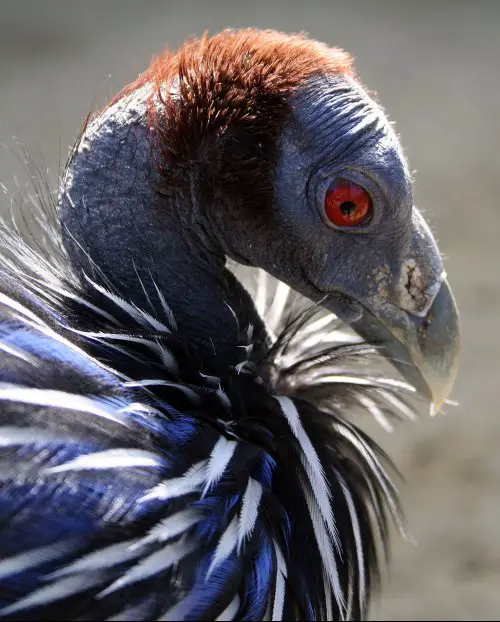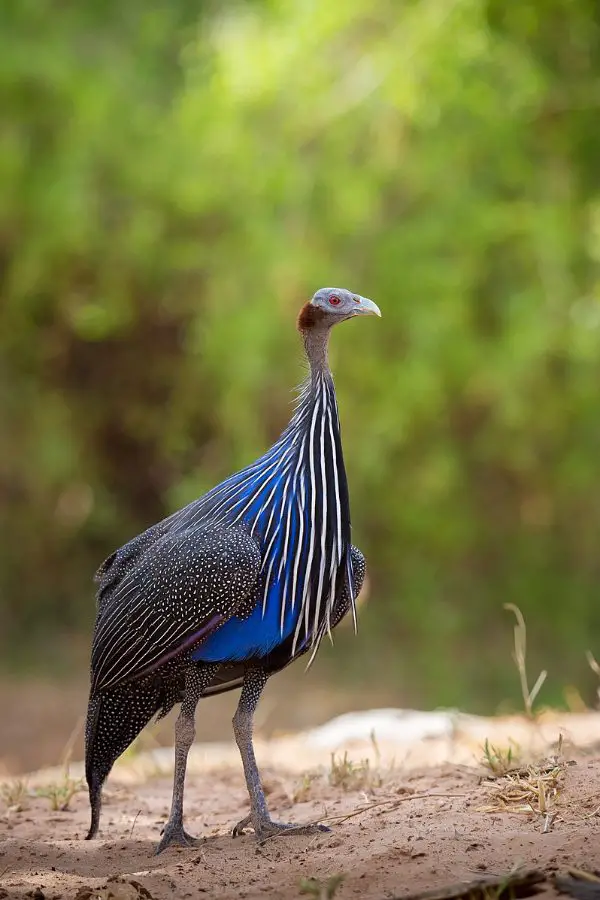The largest guineafowl in the world is the Vulturine Guineafowl. Like most guineafowl, the Vulturine Guineafowl is found mostly in Africa, although some domestic breeders have also tried to raise this bird.
On this page, we ae going to talk about absolutely everything that you need to know about this, quite frankly, stunning breed.
The Roaming Grounds of the Vulturine Guineafowl
This breed of guineafowl is found throughout Tanzania, Kenya, and Ethiopia.

While this may seem like they cover a lot of ground, they do not. It is believed that there are about 10,000 of this breed of guineafowl in the wild, and they live in flocks, but these flocks live fairly close to one another. It isn’t really a widespread bird.
The bird will mostly live in forested areas. This is because the forested areas provide the perfect amount of protection for the evening when they want to roost.
The Look of the Vulturine Guineafowl
By looking at the guineafowl, you can probably work out how it managed to get the name ‘vulture’ into its name. It sort-of looks like one. Well, at least the head of the Vulturine Guineafowl does.
You will probably also notice that this guineafowl doesn’t look like most other guineafowl breeds. Well, not much like them. This is because it is only a little bit related to other guineafowls.
It has its own genus Acryllium, although it is still classed as a Numidede like other guineafowls.
As mentioned previously; this is the largest breed of guineafowl. It stands around 28 in (70 cm) tall. It has a long neck and an unfeathered head.
In fact, this is the only guineafowl to have a completely unfeathered head, hence why it probably looks different from other breeds of guineafowl.
In terms of coloring, the breast of the Vulturine Guineafowl is a bright blue color. The rest of their feathers are black with white speckles on them. It really is an incredibly beautiful bird.

This is one of a few breeds of guineafowl where it is nigh on impossible to tell the males and females apart. They look very similar, and the sound of the guineafolw is very similar in both sexes.
Obviously, they can be sexed when you are up close, but if you saw one of these roaming around in the wild, you wouldn’t have a clue what sex it was.
The Flight of the Vulturine Guineafowl
While this bird is capable of flying short distances, you will rarely see it do so. This is because it is a larger bird. It takes a lot of effort for them to get off of the ground and, when they do, it can never really fly that fast anyway.
If the Vulturine Guineafowl wants to get somewhere or escape from a predator, then it is going to run.
Egg Laying
In the wild, the Vulturine Guineafowl is able to law 6-8 eggs per breeding season. In captivity, this number can go up to 40 per breeding season. This is due to more stable diets, plus a whole load of selective breeding.
While the Vulturine Guineafowl spends most of its time in largish flocks (more on that in a short while), when breeding season rolls around, the flocks will break down into pairs.
They will never roam that far from one another in order to guarantee protection, but you won’t see them roaming around in big groups anymore.
Interestingly, this is one of a few breeds that will share duties in hatching eggs. We are not just talking about the males and females here.
The females will often build nests together and then take it in turns to hatch the eggs.
Like most Guineafowl, this bird looks after its young pretty well. The eggs should hatch 28-days from being laid, assuming they are fertilized.
Once the birds have grown up a little, the larger flock will come together and continue doing whatever they did before. This happens far quicker with these birds than other guineafowl.
The chicks will mature exceedingly quickly. In fact, they are ready to join the rest of the flock and fly within just a couple of days from hatching.
As a Meat Source
There are some breeders that will raise the Vulturine Guineafowl for meat. We aren’t surprised by that. It has large breasts. It is also hunted in the wild, although due to the differing diet in the wild, the bird will taste a bit different.
Captive-bred guineafowl do, by all accounts, taste good, like the Helmeted Guineafowl , which is the most popular domesticated guneafowl in US.
The Food
In the wild, the Vulturine Guineafowl will eat whatever it can get its beak on. This is mostly going to be seeds and invertebrates, although it probably isn’t going to be opposed to eating fruit if it manages to find it.

Unlike other wild breeds of guineafowl, this one doesn’t really venture into human settlements to get food. Most of the food will come from the forests that it resides in.
Vulturine Guineafowl Flock Behavior
Like other guineafowls, this breed does not roam around on its own. Instead, it will travel in flocks of around 25 birds, although there have been flocks that are larger than this, it is rare.
There wouldn’t be enough food to go around. As we said; the only time that the flocks will be smaller is if the birds are in the midst of the breeding season.
At night, the bird is likely to roost in trees, although it can also sleep in bushes if it is roaming around the Savannah, as some of these flocks have been known to do.
Personality
This is an exceedingly aggressive breed. They are so aggressive that they will often fight other birds in their flock.
This often happens when there is not enough food to go around. In fact, this breed is so aggressive that the chicks will even try to kill one another.
This is partly why they are so difficult to raise in captivity. While the food should be enough to go around, the birds also need a lot of space.
If they see a bit of space as their own, then they will be violent towards the bird or other animal that wanders into it.
Related article: Where to buy guineafowl?
